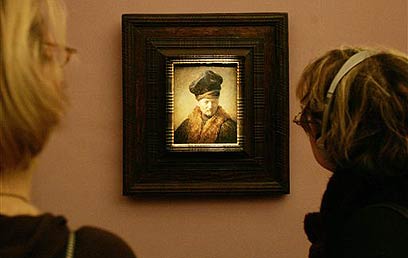
Collected art. Hitler
Photo: AP
His face is one of the best known in the art world, and as the Netherlands celebrates the 400th anniversary of Rembrandt's birth, his life and work retain few secrets. But did you know he was once a Nazi icon?
An exhibition at the Dutch Resistance Museum in Amsterdam recalls the Nazis' largely forgotten mission to incorporate the Dutch painter into fascist ideology, and win sympathy in the Netherlands, which they occupied in 1940.
The artist appeared on Dutch stamps issued during the occupation, a "Rembrandt" prize was awarded for artistic contribution to National Socialist culture, and a Rembrandt opera and film were written.
The Nazis even tried to institute a national holiday on Rembrandt's birthday, July 15, to replace the traditional Queen's Day parties on the date of the Dutch Queen's birthday.
But the Dutch remained largely unenthusiastic, helping to preserve the international standing of the 17th century artist, who painted nearly 100 self-portraits.
The Amsterdam exhibition, which opened in late June, includes the stamps, a 1941 film about Rembrandt, and old posters advertising Rembrandt Day.
Figure for Nazi adulation
When Nazi propagandists looked at Rembrandt's works - admired for their striking use of light and shade and subtle, expressive power - they saw images to fuel their myth of "blood and soil," the idea that those of German blood had a deep bond with their land and a superior, racially-pure character.
Adolf Hitler and other top Nazis collected Rembrandt's works, although little in the painter's thinking or personal history would have naturally branded him a figure for Nazi adulation.
When Hitler looked at "Man with a Golden Helmet," at the time attributed to Rembrandt, he singled out the soldier's heroic features.
"This proves that Rembrandt was a true Aryan and German," Hitler said, according to the Amsterdam museum.
Relations with Jews
The Germans badly needed an image boost after invading the Netherlands in just a few days and Rembrandt, born in Leiden in 1606 and considered typically Dutch for his Protestant faith and proud individualism, seemed the ideal figure.
An 1890 book by German Julius Langbehn had already extolled Rembrandt as an archetypal "Germanic" man, who strove for an authentic portrayal of his land and people.

Rembrandt in Dutch museum (Photo: AP)
Langbehn said Rembrandt's work reflected the German spirit, free of sterile intellectualism and decadence, and that his masterly depiction of light showed he could overcome forces of chaos and darkness.
Some Nazis were not convinced. They pointed out that Rembrandt had lived among Jews, painted Old Testament scenes and Jewish characters such as the rosy-cheeked "Jewish bride."
But these concerns were swept aside as Rembrandt was simply too central to attempts to forge a new Germanic-Dutch identity.
"Rembrandt's nation celebrates its greatest son not as a possession for itself alone, but as one of the greatest and most noble creations of the Germanic spirit," said Tobie Goedewaagen, a leading figure in the Dutch National Socialist movement which supported the Nazis, in 1941.
A 1941 film, made in Amsterdam, maintained Jews were the cause of Rembrandt's financial woes, claiming they bought his paintings cheaply and sold them for a huge profit.
Rembrandt was declared bankrupt in 1656 and forced to leave his house in Amsterdam's most fashionable district for a more modest home. But the real source of his constant money troubles lay in his erratic spending and expensive tastes.
Rembrandt biographer Gary Schwartz believes that although Rembrandt was certainly not the philo-Semite he was often depicted as, he was also no anti-Semite.
"Rembrandt was in the mainstream Christian thinking of his time about Judaism, that Jews were outside of God's redemption."
He was ready to live amongst them but he did spend much time wrangling with them, he said.
'Golden age'
The Nazis, whose 1944 Rembrandt day proved a huge flop in the face of a cynical, resentful audience, were certainly not the first to try to use Rembrandt.
"(The Dutch) did a whitewash job on him in the 19th century," noted Schwartz, saying they linked Rembrandt to their "Golden Age" as a mighty maritime power and wealthy state.
During year-long celebrations ranging from walking tours through Rembrandt's favorite haunts to a musical about his colorful love-life, the Dutch hope finally to present as rounded and complete an image as possible of their beloved national painter.















